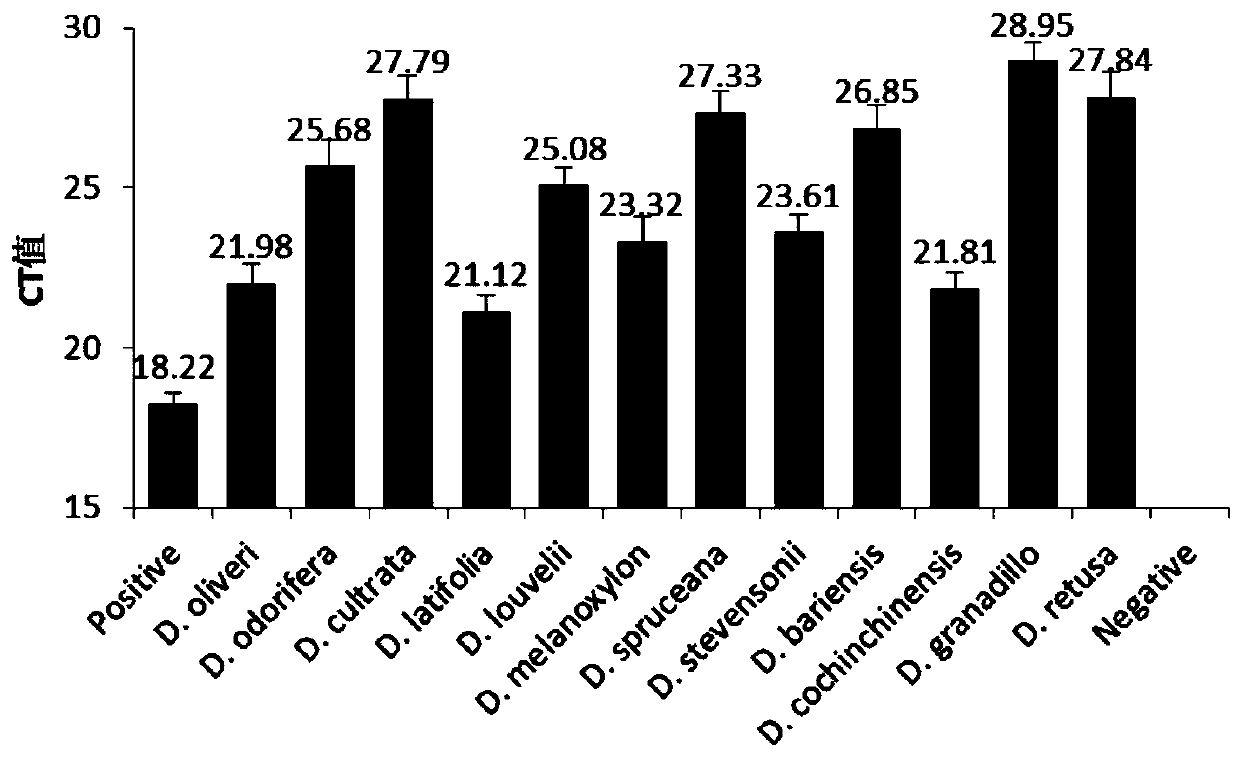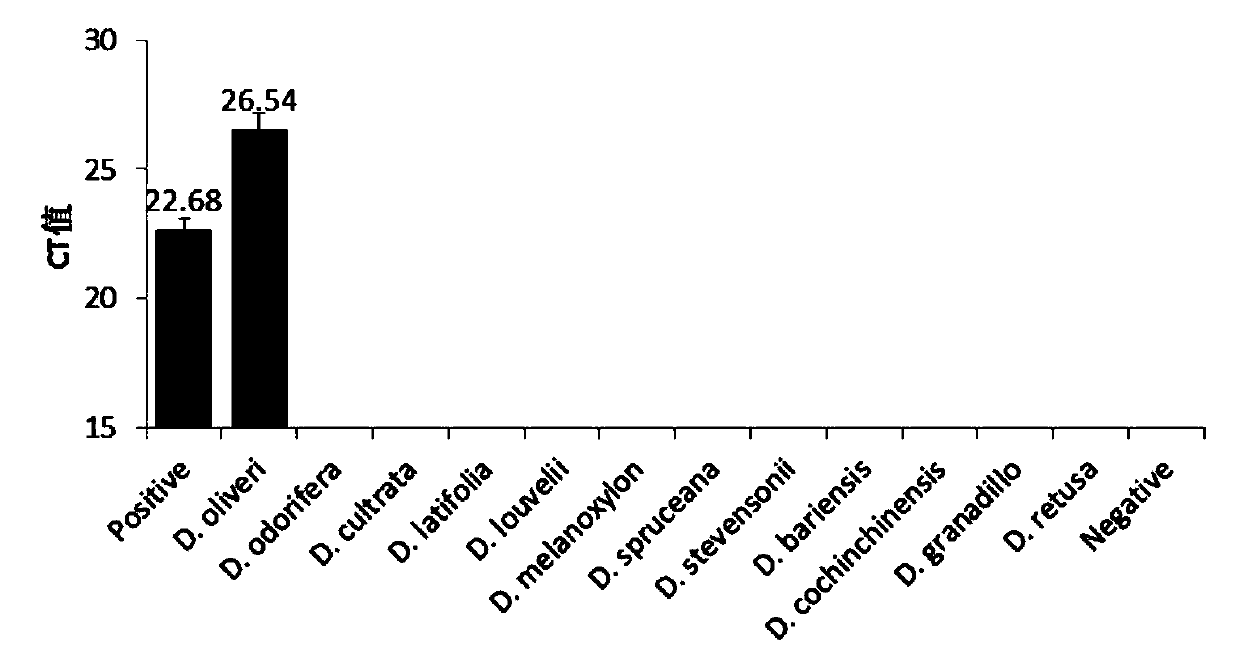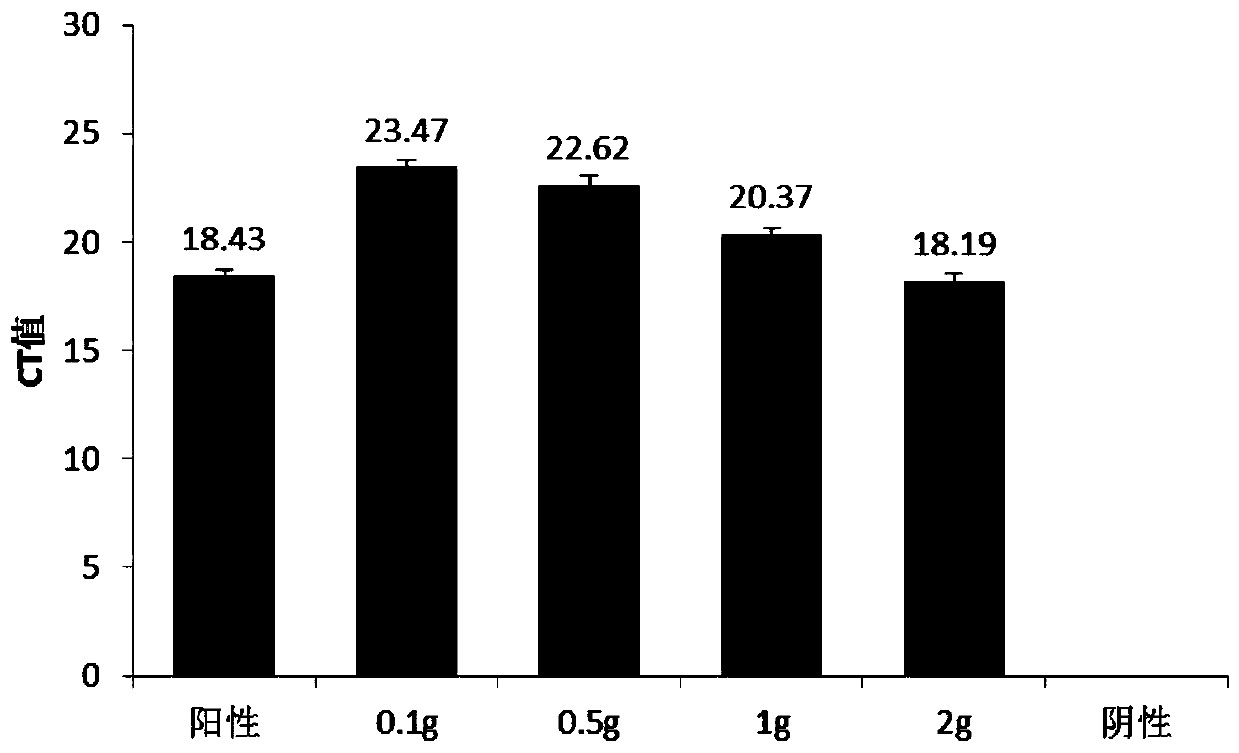Molecular identification method of Dalbergia oliveri and primers and probe of molecular identification method
A technology of molecular identification and probe, which is applied in the field of molecular biology detection of wood species identification, can solve the problems of difficulty in wood identification accuracy and similar material structure, and achieve the effects of easy unification of standards, intuitive analysis, and improved detection sensitivity
- Summary
- Abstract
- Description
- Claims
- Application Information
AI Technical Summary
Problems solved by technology
Method used
Image
Examples
Embodiment 1
[0037] Example 1 detects primers, probes and detection kits of Dalbergia austenifolia
[0038] Using resource information such as NCBI to find out the gene difference sites between Dalbergia austenifolia and other woods, screen out a pair of specific amplification primers (ASHT Primer-F and ASHT Primer-R), and use the primers to amplify A specific probe (ASHT Primer Probe) was set for the growth region. The amplification primer pair and the probe sequence are respectively:
[0039] ASHT Primer-F: 5'-GTTTCTATTGCTCCTTTACTTT-3'
[0040] ASHT Primer-R: 5'-TCTGTTTCTTCTCTAACTTTAGT-3'
[0041] ASHT Primer Probe: 5'-FAM-TACATTGCAAATTCATATG-MGB-3'.
[0042]Homology comparison of the designed primers and probes on NCBI showed that the sequences of the primers and probes were only 100% similar to the sequence of Dalbergia austenifolia, and could not be effectively combined with sequences of other tree species, so only Can amplify and detect Dalbergia austeni.
[0043] A kit for dete...
Embodiment 2
[0051] Embodiment 2: the identification method of real-time fluorescent PCR
[0052] (1) Pretreatment of wood samples:
[0053] The wood surface was thoroughly disinfected with 75% ethanol, rinsed with sterile water and the wood was wiped dry. Cut off the surface of the wood to be tested to avoid contamination by other plant tissues. Take a certain amount of wood samples, add liquid nitrogen and quartz sand to a pre-cooled mortar and grind them into powder for later use. When not used immediately, the sample DNA solution was stored at -20°C until use.
[0054] (2) DNA extraction of wood samples:
[0055] The total DNA of the pretreated wood in step (1) was extracted using Plant Genomic DNA Kit (TIANGEN), and placed in a -40°C refrigerator for later use.
[0056] (3) Real-time fluorescent PCR amplification:
[0057] The DNA extracted in step (2) is subjected to qPCR detection. The amplification conditions are: 95°C, 2min; 95°C, 15s, 55°C, 34s, a total of 40 cycles. The q...
Embodiment 3
[0063] Embodiment 3: DNA extraction and detection
[0064] Separately extract Dalbergia austeni (experimental group 1), control group: Dalbergia japonica, Dalbergia chinensis, Dalbergia broadleaf, Dalbergia lusi, East African Dalbergia, Amazon Dalbergia, Belize Dalbergia , Dalbergia chinensis, Dalbergia cochinchinensis, Dalbergia chinensis, Dalbergia dentata, a total of 11 contrasting genomic DNAs are used as templates, using the reaction system of plant endogenous gene tRNALeu and embodiment 1 and the detection described in embodiment 2 The method is to detect the extracted DNA.
[0065] The primer and probe sequences of tRNALeu are (standard):
[0066] tRNALeu-F: 5'-CGAAATCGGTAGACGCTACG-3'
[0067] tRNALeu-R: 5'-TTCCATTGAGTCTCTGCACCT-3'
[0068] tRNALeu Probe: 5'-FAM-GCAATCCTGAGCCAAATCC-TAMRA-3'
[0069] Such as figure 1 It shows that the DNA of the samples of the experimental group and the control group in Example 3 have been successfully extracted. Among them, the La...
PUM
 Login to View More
Login to View More Abstract
Description
Claims
Application Information
 Login to View More
Login to View More - R&D
- Intellectual Property
- Life Sciences
- Materials
- Tech Scout
- Unparalleled Data Quality
- Higher Quality Content
- 60% Fewer Hallucinations
Browse by: Latest US Patents, China's latest patents, Technical Efficacy Thesaurus, Application Domain, Technology Topic, Popular Technical Reports.
© 2025 PatSnap. All rights reserved.Legal|Privacy policy|Modern Slavery Act Transparency Statement|Sitemap|About US| Contact US: help@patsnap.com



